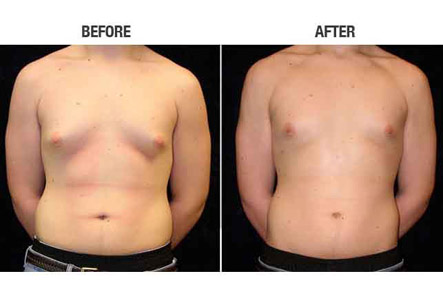Male Breast Reduction
Introduction
Male breast reduction surgery or gynecomastia is the surgical correction procedure for shaping up enlarged or over-developed breasts in male patients.
It can be embarrassing for men to have female-like breasts, which may influence their self- confidence. It is common in men of any age. This condition arises mainly due to hormonal changes, heredity conditions, disease or the use of certain drugs. It may lead to emotional discomfort and impair self confidence of the person having it. Some men may even try to shun certain physical activities and intimacy to hide this state. Such male patients can achieve a scar-free and aesthetic flat mascular chest with normal muscle outlines with advanced techniques of this surgery.
Gynecomastia is characterized by:
• Excessive deposits of localized fat
• Excessive development of glandular tissue
• A combination of both mentioned above
• This condition may be present unilaterally (one breast) or bilaterally (both breasts)
Gynecomastia is a medical condition that can affect men of all ages, but especially teenagers and men who are on certain types of drug therapy

Men can undergo breast reduction surgery if they pass the following criteria:
• If physically healthy and of relatively normal weight
• If expecting realistic goals
• If breast development has stabilized in these men. Adolescents may benefit from surgery, although secondary procedures may be needed in the future should breast development continue.
• If they are bothered by the feeling that their breasts are too large
Surgical reduction of breasts can be performed best in following cases:
• Healthy males who do not have a life-threatening illness or medical ailments that can impair healing
• Men with a positive outlook and specific goals in mind for improving the physical symptoms of enlarged breasts
• Men whose condition cannot be corrected through alternative medical treatments
• Non-smokers and non-drug users
Procedure
Plastic surgery to correct gynecomastia is also called reduction mammoplasty. Male breast reduction surgery, performed under general or local anaesthesia, is a day-care surgery. This cosmetic surgery reduces breast size by flattening and enhancing the chest contours. Excess fat present in the breast area can be excised by liposuction surgery. Any remaining tough gland tissue is cut and removed by taking a small incision within areola. In severe cases of gynecomastia, the weight of excess breast tissue may cause the breasts to droop and stretch the areola. In these cases the position and size of the areola can be surgically improved and excess skin may be reduced. Compression garment is compulsory post- surgery for one month. Most regular activities can be resumed in a couple of weeks.
• Anaesthesia- Medications are administered for patient’s comfort during the surgical procedure. It can be either intravenous sedation or general anaesthesia.
• Liposuction- Liposuction technique is used in cases where gynecomastia is primarily the result of excess fatty tissue. This requires insertion of a thin hollow tube called a cannula through numerous small incisions. The cannula is moved to and fro in a controlled manner to loosen the excess fat, which is then removed from the body by vacuum suction. There are diverse liposuction techniques that may be used.
• Excision- Excision techniques are recommended where glandular breast tissue or excess skin must be removed to correct gynecomastia. Excision also is necessary if the areola will be reduced, or the nipple repositioned to a more natural male contour. Incision patterns vary depending on the specific conditions and surgical preference. Sometimes gynecomastia is treated with both liposuction and excision. Any surgical treatment to correct gynecomastia will require incisions. While most incision lines are concealed within natural contours, some may be visible and are a necessary result of breast reduction surgery.
• Recovery- After surgery, dressings or bandages will be applied to the incisions and an elastic bandage or support garment may be used to minimize swelling and support the new chest contour as it heals. A small, thin tube may be temporarily placed under the skin to drain any excess blood or fluid that may collect.
• Specific instructions-
Care for the surgical site post surgically
medications to apply or take orally to aid healing and to avoid the risk of infection
specific concerns to look for at the surgical site or in general health
regular follow ups